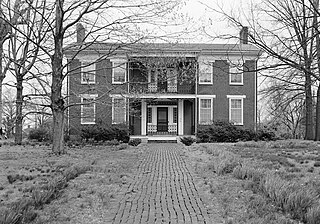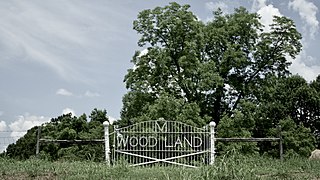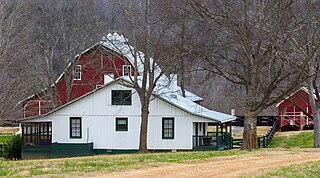
Lucius Quintus Cincinnatus Lamar II was a Confederate soldier, American politician, diplomat, and jurist. A member of the Democratic Party, he represented Mississippi in both houses of Congress, served as the United States Secretary of the Interior, and was an associate justice of the Supreme Court of the United States. He also served as an official in the Confederate States of America.

Verdura Plantation was a large cotton plantation of 9,440 acres (3,820 ha) in eastern Leon County, Florida, United States established by Benjamin Chaires.
In 1824, in appreciation of the enormous service rendered to this country by the Marquis de Lafayette during the Revolutionary War, Congress voted to grant him a full township in the Florida Territory. This tract was called the Lafayette Land Grant and encompassed over 23,000 acres. While the Marquis never came to visit his property, he designated an agent to sell parcels of it on his behalf. The 2,400 acres upon which Goodwood Plantation was sited was purchased by Hardy Croom from the Lafayette Grant in 1834.

Blackacre State Nature Preserve is a 271-acre (110 ha) nature preserve and historic homestead in Louisville, Kentucky. The preserve features rolling fields, streams, forests, and a homestead dating back to the 18th century. For visitors, the preserve features several farm animals including horses, goats, and cows, hiking trails, and a visitor's center in the 1844-built Presley Tyler home. Since 1981, it has been used by the Jefferson County Public Schools as the site of a continuing environmental education program. About 10,000 students visit the outdoor classroom each year.

The Poplar Hill Mansion is a historic U.S. mansion located at 117 Elizabeth Street, Salisbury, Maryland and is open to the public as a house museum.
Barleywood is a farm in Jefferson County, West Virginia, on land once owned by Samuel Washington, brother of George Washington. The farm is close to Samuel's manor house, Harewood, from which the Barleywood property was subdivided in 1841. The Barleywood house was built in 1842, as well as several outbuildings which survive. The house sat vacant from the 1960s to the late 2010s and during that time it suffered from vandalism. It is now a private residence.
Bailey House may refer to:

Troy, also known as Troy Hill Farm, is a historic slave plantation home located at Elkridge, Howard County, Maryland, United States. It is associated with the prominent Dorsey family of Howard County, who also built Dorsey Hall.

Botany Bay Heritage Preserve & Wildlife Management Area is a state preserve on Edisto Island, South Carolina. Botany Bay Plantation was formed in the 1930s from the merger of the Colonial-era Sea Cloud Plantation and Bleak Hall Plantation. In 1977, it was bequeathed to the state as a wildlife preserve; it was opened to the public in 2008. The preserve includes a number of registered historic sites, including two listed in the National Register of Historic Places: a set of three surviving 1840s outbuildings from Bleak Hall Plantation, and the prehistoric Fig Island shell rings.

The Porter House is a historic home located at 407 South Dunlap Street, Paris, Henry County, Tennessee.

Dogham Farm, previously known as Doggams, is a historic home and farm located in Charles City, Charles City County, Virginia. In 1642, Joseph Royall patented 600 acres on the north side of the James River in Charles City County. The plantation he named "Doggams" later became known as "Dogham" in the 18th century. Following the death of Joseph Royall, his widow married Henry Isham. Dogham is notable not only for its antiquity but also for its continuous ownership and occupation by the same family - the property remains in the Royall and Isham lines today.

Providence Plantation and Farm, also known as Fogg House and Farm, is a historic plantation house located near Newtown in King and Queen County, Virginia. The two story, 3-bay Federal style brick main house was built about 1826, and expanded circa 1840. Also on the privately-held property, demonstrating the changes over time as the plantation which once encompassed about 1299 acres shrunk to the listed 6.47 acres, are the contributing two-story Reconstruction-era granary and carriage house, and Great Depression-era hen laying house, two-story sweet potato shed, and mechanic's shop.

The Woodland Plantation is a historic Southern plantation near Church Hill, Jefferson County, Mississippi. It retains its original antebellum 230 acre size, and has the tradition of primarily supplying hay to the area cattle. It also has a pecan orchard.
The Whitfield family was a prominent American political family of the Southern states. The Whitfields formed the American branch of the British Whitfield family - having descended from the British aristocracy, particularly the Earls of Kilmorey and having established colonial residency under Sir. Thomas Whitfield, whom headed East India Trading for the British Empire. In early days of Colonial America, the family emigrated to Virginia in the seventeenth century, particularly, Nansemond County, Virginia from Lancashire, England.

Dunvegan, a.k.a. Norfleet-Cochran House is a historic "English Basement" cottage in Holly Springs, Mississippi, USA. It was built in 1845 for Jesse P. Norfleet, a cabinetmaker from Virginia who married the daughter of a prosperous Mississippi planter. Norfleet eventually became a planter and local business owner. In the 1970s the home was renamed Dunvegan for the town of Dunvegan on the Scottish island of Skye.
Airdrie, a.k.a. Petway House or the Buell-King House, is a historic house and former plantation in Nashville, Tennessee. Built as a log house from 1797 to 1808, it was a Southern plantation with African slaves in the Antebellum era. After the American Civil War, it belonged to Union veterans.

Beech Grove is a historic mansion in Nashville, Tennessee. Built as a log house circa 1850, it was a Southern plantation with African slaves in the Antebellum era. In the 1910s, it became a livestock farm.

The McGavock-Gatewood-Webb House, also known as Blue Fountain, is a historic house in Nashville, Tennessee, USA. It was built in the 1840s.

Dozier Farm, also known as Cliffview Farm, is a historic mansion in Nashville, Tennessee, U.S..

The Alexander Ewing House is a historic mansion in Nashville, Tennessee, U.S. The two-story plantation home was built in 1821 in the Federal architecture style for Alexander Ewing. It is constructed of brick with a stone foundation and a gable roof. Both the north and south side elevations feature a pair of chimneys connected by a parapet wall. The house has been listed on the National Register of Historic Places since November 25, 1980.

















